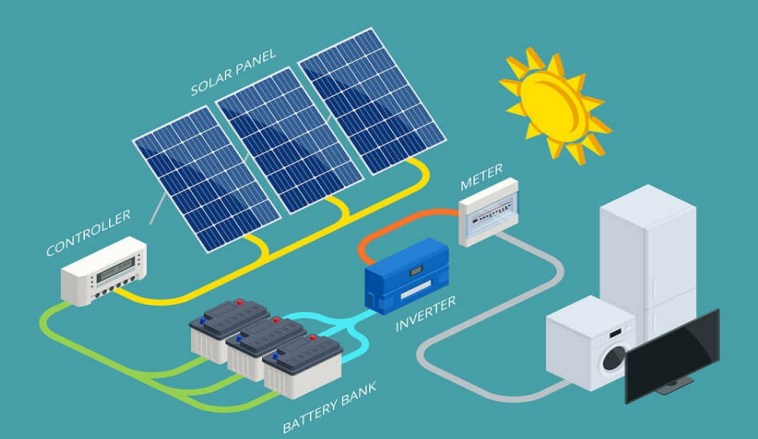
Photovoltaic (PV) System Overview
A photovoltaic (PV) system, commonly known as a solar power system, is designed to
convert sunlight into usable electricity. This system is composed of several key components
working together:
Solar Panels: These panels capture sunlight and convert it into direct current (DC)
electricity.
Solar Inverter: This device converts the DC electricity generated by the solar panels into alternating current (AC) electricity, which is usable by most electrical systems in homes and businesses.
Mounting System: This provides the structure to securely hold the solar panels in place.
Cabling and Electrical Accessories: These are necessary to connect and integrate all components into a functioning system.
Optional Components: Some systems include a solar tracking system to optimize
performance or an integrated battery solution to store electricity, especially as the cost of storage devices continues to decrease.
Strictly speaking, the term “solar array” refers only to the collecon of solar panels, the
most visible part of the PV system. It does not include the other hardware components,
often referred to as the balance of system (BOS).
It’s important to note that PV systems convert sunlight directly into electricity and should not be confused with other solar technologies like concentrated solar power (CSP) or solar thermal systems, which are primarily used for heating and cooling purposes.
Function of a Solar Power System
Solar Panels: Solar panels absorb and convert sunlight into direct current (DC) electricity.
Inverter: The generated DC electricity is converted into alternating current (AC) by an inverter, which is installed within the premises of a house or commercial area.
Mounting and Electrical Accessories: The mounting system, cabling, and other electrical accessories are set up to create a fully functional solar power system. To enhance performance, a solar tracking system may also be used, especially as the prices for storage devices connue to decline.
Net Metering: The electricity generated by the solar system is tracked by a “Net Meter,” “Net Account,” or “Net Plus” system, which may be installed by the utility provider (CEB or LECO) once grid connectivity is approved.
Income Generation: Depending on your system’s generation capacity and your electricity usage, you have three different options for generating additional income through your solar
power system.
Promising Schemes for Distributed Renewable Energy Generation
One promising approach to distributed renewable energy generation is the introduction of Net Accounting, Net Metering, and Net Plus schemes. These programs encourage customers to generate their own electricity through renewable sources such as solar, hydro, or biomass directly at their premises. Net metering programs, in particular, make self-generation more attractive by eliminating the need to size systems precisely to meet a customer’s power needs or to install on-site storage and power conditioning devices. The deployment of distributed renewable energy through net metering offers several environmental, economic, and social benefits.
Under the Net Metering scheme, consumers pay only for the net amount of electricity they consume. If a consumer’s solar energy system generates more electricity than they consume, the surplus can be carried forward for future use over a period of 20 years. However, no payment is made by CEB or LECO for the surplus electricity.
In the Net Accounting scheme, if the solar energy system generates more electricity than the consumer uses, the consumer will be paid for the excess at the rate of Rs 22.00 per unit for the first seven years after installation. From the 8th to the 20th year, the rate drops to Rs 15.50 per unit.
The Net Plus system allows consumers to be paid for all the electricity generated by their solar energy system, regardless of their own electricity consumption. For the first seven years after installation, the rate is Rs 22.00 per unit. From the 8th to the 20th year, the rate is Rs 15.50 per unit. Unlike Net Metering and Net Accounting, there is no linkage between electricity generation and consumption. Consumers pay for the electricity they use at the standard tariffs, while CEB or LECO pays separately for the total amount of power generated by the solar energy system.
Advantages of Using Solar PV Systems
Environmental Contribution: By becoming an electricity provider to the national grid, you not only earn a monthly income but also contribute positively to the environment.
Financial Support: You can access loans with low interest rates and a 7-year repayment period, available island-wide.
Seamless Installation: There’s no need to alter your current home electricity circuit when installing a new solar PV system.
Eliminate Electricity Bills: With a solar PV system, you can completely eliminate your electricity bills, making your home or business more energy-independent.
Cost Savings: Solar power is a completely free and abundant energy source. By adopting solar energy, the country can reduce its reliance on costly coal and fossil fuels, leading to significant savings in foreign exchange.
Environmental Protection: Utilizing solar energy can prevent the annual emission of 150,000 metric tons of CO2, contributing to a healthier environment and helping combat climate change.
Energy Security: The widespread deployment of solar energy stations across the country enhances the stability and resilience of the national electricity grid, ensuring a more reliable power supply.
Efficiency Gains: Solar power generation reduces energy losses during transmission, making the energy system more efficient and sustainable.
Frequently Asked Questions
What kind of solar system do you have and introduce them
Off-grid system – It’s a solar power system that you can use in power cut or without the CEB/leco.
Hybrid – It’s the solar power system consist of both on-grid and off-grid systems.
What are the benefits you gain after using solar system?
Off-grid system – without costing anything you can get the power anytime.
Hybrid system – you can gain all the advantages when using the hybrid system.
Please download our document to see specific data of the service and how we work.
Let’s Start Work Together
24 Hrs






